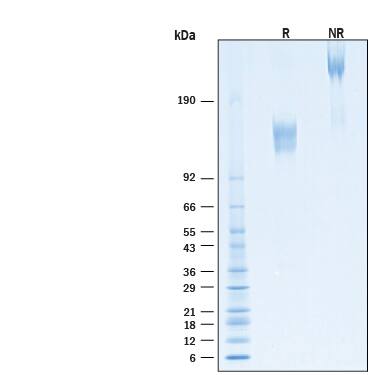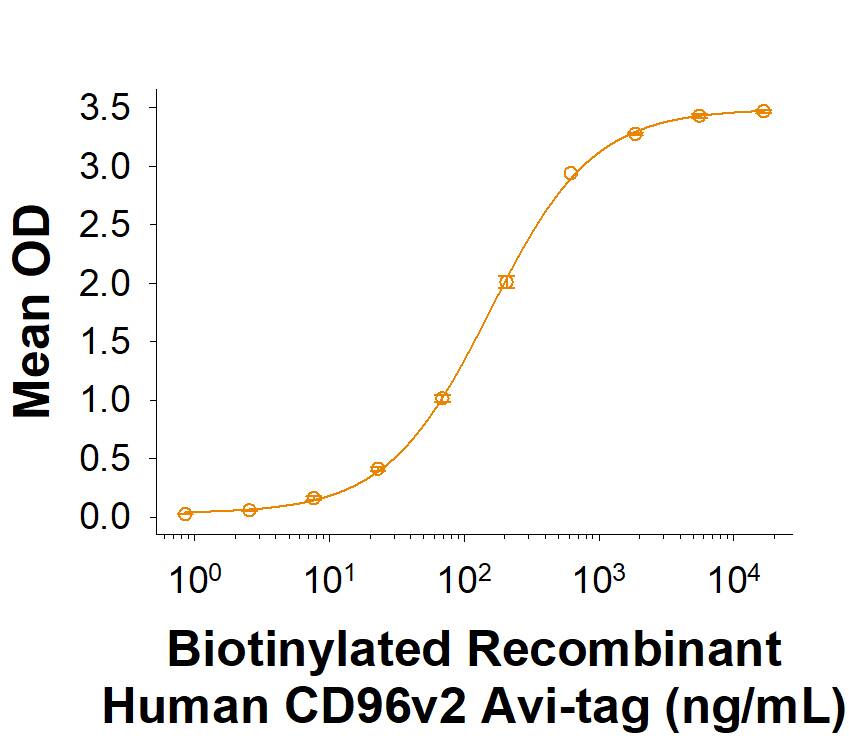Recombinant Human CD96v2 Fc Chimera Avi-tag Protein, CF
R&D Systems, part of Bio-Techne | Catalog # AVI9556

Key Product Details
Source
CHO
Accession #
Structure / Form
Disulfide-linked homodimer
Biotinylated via Avi-tag
Biotinylated via Avi-tag
Conjugate
Biotin
Applications
Bioactivity
Product Specifications
Source
Chinese Hamster Ovary cell line, CHO-derived human CD96 protein
| Human CD96v2 (Lys25-Met503) Accession # NP_005807.1 |
IEGRMD | Human IgG1 (Pro100-Lys330) |
Avi-tag |
| N-terminus | C-terminus | ||
Purity
>95%, by SDS-PAGE visualized with Silver Staining and quantitative densitometry by Coomassie® Blue Staining.
Endotoxin Level
<0.10 EU per 1 μg of the protein by the LAL method.
N-terminal Sequence Analysis
Lys25
Predicted Molecular Mass
82 kDa
SDS-PAGE
117-146 kDa, under reducing conditions.
Activity
Measured by its binding ability in a functional ELISA.
Biotinylated Recombinant Human CD96v2 Fc Chimera Avi-tag (Catalog # AVI9556) binds Recombinant Human CD155/PVR Fc Chimera (Catalog # 9174-CD) with an ED50 of 30.0-300 ng/mL.
Biotinylated Recombinant Human CD96v2 Fc Chimera Avi-tag (Catalog # AVI9556) binds Recombinant Human CD155/PVR Fc Chimera (Catalog # 9174-CD) with an ED50 of 30.0-300 ng/mL.
Scientific Data Images for Recombinant Human CD96v2 Fc Chimera Avi-tag Protein, CF
Biotinylated Recombinant Human CD96v2 Fc Chimera Avi-tag Protein Binding Activity.
Biotinylated Recombinant Human CD96v2 Fc Chimera Avi-tag Protein (Catalog # AVI9556) binds Recombinant Human CD155/PVR Fc Chimera (9174-CD) with an ED50 of 30.0-300 ng/mL.Biotinylated Recombinant Human CD96v2 Fc Chimera Avi-tag Protein SDS-PAGE.
2 μg/lane of Biotinylated Recombinant Human CD96v2 Fc Chimera Avi-tag Protein (Catalog # AVI9556) was resolved with SDS-PAGE under reducing (R) and non-reducing (NR) conditions and visualized by Coomassie® Blue staining, showing bands at 117-146 kDa, and 230-290 kDa, respectively.Formulation, Preparation and Storage
AVI9556
| Formulation | Lyophilized from a 0.2 μm filtered solution in PBS with Trehalose. See Certificate of Analysis for details. |
| Reconstitution | Reconstitute at 250 μg/mL in PBS. |
| Shipping | The product is shipped at ambient temperature. Upon receipt, store it immediately at the temperature recommended below. |
| Stability & Storage | Use a manual defrost freezer and avoid repeated freeze-thaw cycles.
|
Background: CD96
References
- Wang, P.L. et al. (1992) J. Immunol. 148:2600.
- Meyer, D. et al. (2009) J. Biol. Chem. 284:2235.
- Hosen, N. et al. (2007) Proc. Natl. Acad. Sci. USA 104:11008.
- Xie, W. et al. (2010) Cytometry A 77:840.
- Eriksson,E. M. et al. (2012) PLOS One 7:e51696
- Kaname, T. et al. (2007) Am. J. Hum. Genet. 81:835.
- Seth, S. et al. (2007) Biochem. Biophys. Res. Commun. 364:959.
- Protein Accession # BAE32358.
- Gong, J. et al. (2008) Clin. Exp. Immunol. 155:207.
- Fuchs, A. et al. (2004) J. Immunol. 172:3394.
- Stanietsky, N. and O. Mandelboim (2010) FEBS Lett. 584:4895.
- Xu, Z. and B. Jin (2010) Cell. Mol. Immunol. 7:11.
Alternate Names
CD96, TACTILE
Gene Symbol
CD96
UniProt
Additional CD96 Products
Product Documents for Recombinant Human CD96v2 Fc Chimera Avi-tag Protein, CF
Product Specific Notices for Recombinant Human CD96v2 Fc Chimera Avi-tag Protein, CF
For research use only
